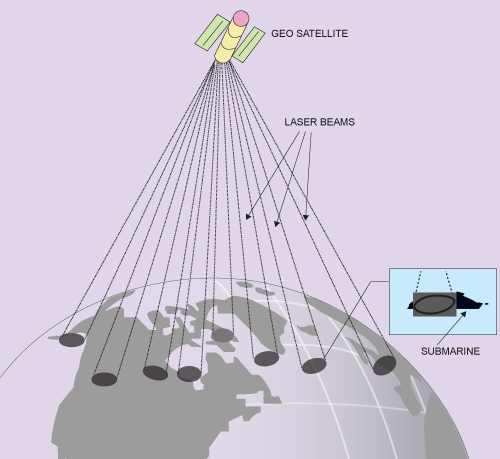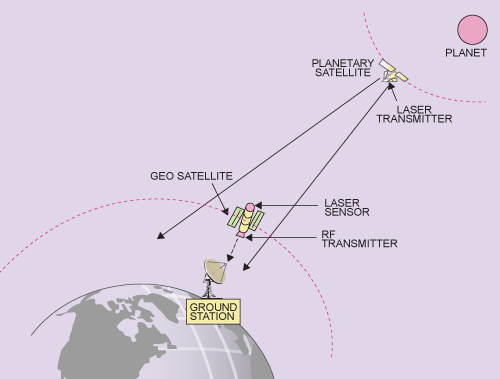The current drive to the laser varies between two values corresponding to the low and high levels of the TTL pulse stream. As a result, the laser beam gets intensity modulated, i.e., its intensity or power gets modulated. It is a type of pulse amplitude modulation. The modulated laser beam is transmitted towards the receiver. The laser communication needs line-of-sight conditions, i.e., the transmitter and receiver should be in line-of-sight.
Receiver
The modulated laser beam falls on the photo diode (type FND100). FND100 is a silicon PIN photo diode. The corresponding current signal generated by the photo diode is converted into an equivalent voltage signal, which is then amplified in a non-inverting amplifier circuit configured around op-amp AD829—a high-speed, high- bandwidth op-amp.
The amplified signal is then fed to a voltage comparator configured around op-amp comparator LM319, which is a high-speed dual comparator. One of the two comparators available on the chip has been used here. The comparator output is a TTL compatible pulse stream representing data.
This pulse stream is then fed to a TTL buffer of non-inverting type (SN 74LS244). 74LS244 is a hex non-inverting buffer. Three buffers are used in parallel for higher current drive capability. The buffer output feeds the TTL/CMOS input of one of the drivers in the MAX232 converter. The corresponding EIA232 output feeds the PC through the serial port. The hyper terminal software in the PC converts the EIA232 bit stream back to a data file, which is stored in the memory and is available on the desktop.
Laser communication—advantages and applications
Fibre-optic communication can be implemented for a longer distance underwater as compared to a laser system since distortion is much higher underwater than in free space, but underwater laser communication gives us the distinct advantage of flexibility. Fibre-optic communication can only be done where the optical fibre communication setup is available and installed. Two submarines can easily transfer data anywhere in real time using an underwater laser system, just by establishing line-of-sight.


Laser communication represents a mature, reliable approach for broadband access. Such systems have been engineered to provide robust performance that is highly competitive with other access approaches, offering high capacity, excellent availability of 99.9 per cent, lowest cost per bps, and rapid deployment in less than one hour. The use of an encoder and decoder allows the development of secure communication links. Secure optical communication links are being extensively used in the defence industry to transmit secret information. These systems are compatible with a wide range of applications and markets, and are sufficiently flexible to be easily implemented using a variety of different architectures. Because of these features, market projections indicate healthy growth for optical wireless sales.
Microwaves cannot be used for underwater laser communication as they do not penetrate through water. Very-low-frequency sound waves transmit through water but they cannot enable high rates of data transfer. Blue-green lasers penetrate through water and are used for high-speed communication applications.
Inter-satellite links employ infrared laser beams for transmitting data from satellite to satellite. Lasers are used, as they do not suffer from attenuation in space and do not have precise pointing requirements.
The application potential of laser communication is expanding at a brisk pace and many new uses are emerging. Laser communication is also being used for satellite-to-satellite links, satellite-to-submarine communication and interplanetary TV links.
Emerging trends in laser communication
Satellites can be used to communicate with many submarines that are submerged in sea water at depths of 100 metres or so. This would eliminate the need for submarines to come to the surface to establish communication, which would reduce their vulnerability. This concept is highlighted in Fig. 4. Satellites in geostationary orbit transmit a large number of narrow blue-green laser beams to create random spots on the ocean, with each beam transmitting encrypted data. A large number of spots are generated, creating empty positions so as not to give away the location of the submarines. Blue-green laser is used for maximal penetration in sea water.
The concept of the interplanetary TV link is shown in Fig. 5. The setup makes use of a satellite orbiting around a planet, with which the link has to be established, and a satellite moving in a geostationary orbit around the earth. The planetary satellite makes use of a low-power laser to transmit signals. The earth-orbiting satellite will have a sensor to receive the optical signal, process it and convert it into microwave signals. The signal is converted from the optical spectrum to the microwave spectrum, as the optical signals do not penetrate clouds and are highly attenuated by rain. The conversion therefore allows the establishment of a non-interruptive link, which enables the monitoring of events happening on different planets on a real-time basis.
Underwater laser communication is an immensely interesting and attractive research topic for scholars and academics. Many advanced countries around the world are trying to successfully implement the technology for military purposes. Successful implementation of this technology for long- distance use is a challenging and uphill task; however, if achieved, it will be a major step forward in the field of communication.
The author is a technical editor trainee with Wiley Publications






